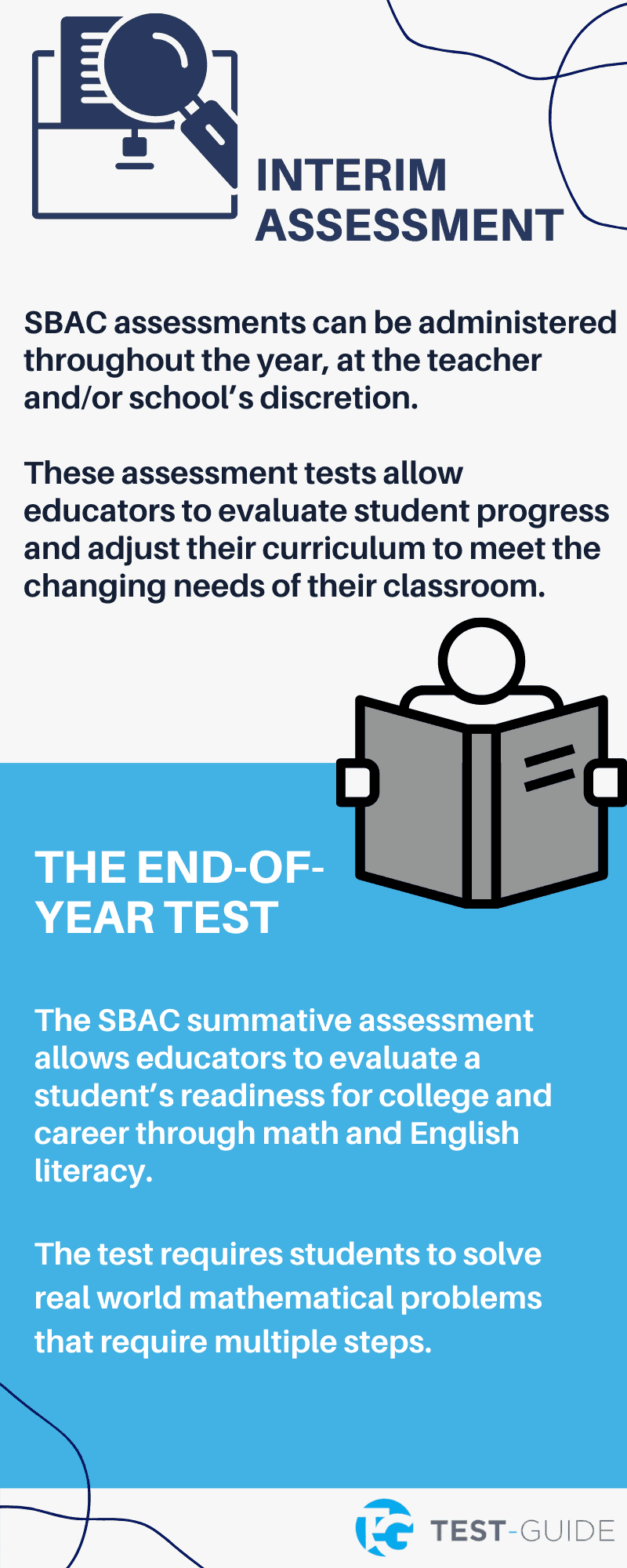All SBAC Practice Tests
The Smarter Balanced Assessment Consortium, or SBAC, is an association dedicated to providing students, parents, and educators with standardized tests. More specifically, the SBAC creates tests that align with the Common Core State Standards.
Take an SBAC practice test below to gauge where you are at.
Overview of the SBAC
Starting in 2015, the SBAC began assessing students in grades 3 through 11. These tests assess a student’s abilities in math and language arts (English). While the SBAC is not implemented in every state, it does have numerous member states:
- California
- Connecticut
- Delaware
- Hawaii
- Idaho
- Maine
- Michigan
- Montana
- Nevada
- New Hampshire
- North Dakota
- Oregon
- South Dakota
- Vermont
- Washington
- West Virginia
- Wisconsin
It is also important to note that the SBAC assessment varies slightly by state. To better understand how each state administers the SBAC assessment, create an account on the official SBAC website and click on the test details for your state right here.
While every state’s SBAC assessment covers the same topics, the formats vary slightly and may feature greater emphasis on certain topics and question types over others.
Each SBAC assessment is also unique to a student’s grade level. The tests are meant to evaluate the level of a student’s math and language abilities at various ages, so the questions and difficulty vary accordingly.
However, no matter the state or grade level, there are two different categories of SBAC assessment available to educators:

The Optional Periodic Test (Interim Assessment)
Though optional, this SBAC assessment can be administered throughout the year, at the teacher and/or school’s discretion. These assessment tests allow educators to evaluate student progress and adjust their curriculum to meet the changing needs of their classroom.
Like other SBAC assessments, the optional periodic test analyzes students on grade-specific math and language skills. You can learn more about topics, questions, and test formats for each grade level right here.
Summative Assessment (The End-of-Year Test)
The SBAC summative assessment allows educators to evaluate a student’s readiness for college and career through math and English literacy. While similar in design to the optional periodic tests, the summative assessment consists of two parts: the computer adaptive test and the performance task.
The test requires students to solve real world mathematical problems that require multiple steps. Additionally, the summative assessment requires students to demonstrate their writing abilities.
SBAC Assessment Administration
Member states coordinate with the SBAC to properly administer SBAC assessments. However, administration is ultimately handled by individual schools, administrators, and/or educators. This means that the exact process will vary for each student, depending on their location, school, and teacher.
Though the summative assessment is only administered once annually, the periodic test can be administered throughout the year.
What Happens During the SBAC Assessment?
As previously stated, the specific testing experience will vary for each student. That said, every test is administered in a computerized format at a participating school or testing facility. This guarantees that the content of each test remains consistent for every student in a given grade level.
Both the periodic test and the summative assessment are administered in the same way. For more information on test administration, consult the Department of Education website for your state.
Who is Eligible to Take the SBAC Assessment?
SBAC assessment eligibility is dependent on grade level and state membership. The SBAC assessment is administered to students starting in the 3rd grade. Any student that has not reached the 3rd grade will not be eligible. The cut-off for SBAC assessment administration is the 11th grade.
This means that any student in their senior year of high school will no longer be eligible to take the test.
The SBAC assessment is only administered in affiliate member states. Not every state participates in the Smarter Balanced Assessment Consortium. If the state in which you live does not participate in the SBAC, you will not be eligible to take the test.
SBAC Assessment Scores
SBAC assessment scores are reported in two separate ways: scaled scores and achievement levels. The scaled score is a more traditional score that gives students, parents, and educators a quantitative measurement of a student’s abilities.
This numerical score falls on a scale from about 2000 to 3000, with the numbers accumulating after the completion of each subsequent grade level. As a student takes more SBAC assessments, these numerical scores will show their progress over time.
The scaled score is then used to determine a student’s achievement level. There are 4 levels that each encompass a range of scores. A student’s level is a good indication of their broader knowledge base and college/career readiness. For more information on SBAC scoring, consult this link.
Frequently Asked Questions
Which states participate in the SBAC?
There are currently 17 member states:
- California
- Connecticut
- Delaware
- Hawaii
- Idaho
- Maine
- Michigan
- Montana
- Nevada
- New Hampshire
- North Dakota
- Oregon
- South Dakota
- Vermont
- Washington
- West Virginia
- Wisconsin
There are also additional states that are affiliated with the SBAC, but do not administer any SBAC assessments (Iowa, North Carolina, and Wyoming).
Even if you don’t live in a Smarter Balanced state or territory, you can try out an SBAC practice test.
How many SBAC Assessments will I need to take?
The answer to this question will depend on your specific curriculum. Some teachers administer multiple periodic tests throughout the year, while others only use the summative test annually. We offer various SBAC practice tests for students to hone their skills.
That said, most students in member states will take at least nine SBAC assessments throughout elementary, middle, and high school.
How do educators prepare students for the SBAC assessment?
Teachers in member states are provided with a wide range of educational resources via the Digital Library. These resources help teachers keep students focused on cultivating math and language skills for the long-term.
To learn more about the Digital Library and other vital resources, check out the SBAC website.

